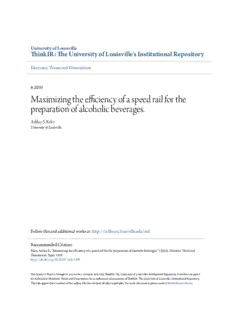Table Of ContentUUnniivveerrssiittyy ooff LLoouuiissvviillllee
TThhiinnkkIIRR:: TThhee UUnniivveerrssiittyy ooff LLoouuiissvviillllee''ss IInnssttiittuuttiioonnaall RReeppoossiittoorryy
Electronic Theses and Dissertations
8-2010
MMaaxxiimmiizziinngg tthhee eeffifficciieennccyy ooff aa ssppeeeedd rraaiill ffoorr tthhee pprreeppaarraattiioonn ooff
aallccoohhoolliicc bbeevveerraaggeess..
Ashley S. Riley
University of Louisville
Follow this and additional works at: https://ir.library.louisville.edu/etd
RReeccoommmmeennddeedd CCiittaattiioonn
Riley, Ashley S., "Maximizing the efficiency of a speed rail for the preparation of alcoholic beverages."
(2010). Electronic Theses and Dissertations. Paper 1209.
https://doi.org/10.18297/etd/1209
This Master's Thesis is brought to you for free and open access by ThinkIR: The University of Louisville's Institutional
Repository. It has been accepted for inclusion in Electronic Theses and Dissertations by an authorized administrator
of ThinkIR: The University of Louisville's Institutional Repository. This title appears here courtesy of the author, who
has retained all other copyrights. For more information, please contact [email protected].
MAXIMIZING THE EFFICIENCY OF A SPEED RAIL FOR THE
PREPARATION OF ALCOHOLIC BEVERAGES
By
Ashley S. Riley
B.S. Mathematics, Saint Mary-of-the-Woods College, 2009
A Thesis
Submitted to the faculty of the
Graduate School of the University of Louisville
In Partial Fulfillment of the Requirements
For the Degree of
Master of Science
In
Industrial Engineering
Department of Industrial Engineering
J.B. Speed School of Engineering
University of Louisville
Louisville, KY
August 2010
Copyright 2010 by Ashley Riley
All rights reserved
MAXIMIZING THE EFFICIENCY OF A SPEED RAIL FOR THE PREPARATION OF
ALCOHOLIC BEVERAGES
By
Ashley S. Riley
B.S. Mathematics, Saint Mary-of-the-Woods College, 2009
A Masters thesis approved on
July 16,2010
By the following Committee:
Dr. William E. Biles, P.E.
Dr. Gail W. DePuy, P.E.
Dr. C. Tim Hardm
II
ABSTRACT
MAXIMIZING THE EFFICIENCY OF A SPEED RAIL FOR THE
PREPARA TION OF ALCOHOLIC BEVERAGES
Ashley Riley
July 16, 2010
Typically bartenders will arrange liquor bottles in a bar based on their own
preferences. This research project describes an alternative way to arrange the bottles on
the speed rail more efficiently. This will allow bartenders to make drinks quicker and
easier. The objective of this study is to develop some sort of heuristic using block
diagramming to make every speed rail more efficient.
For this project three different bars' speed rails were observed. The factors
considered were the top 20 selling mixed drinks at each bar and their current speed rail
setup. A generalized heuristic was used to evaluate the speed rail and make changes to
try and increase its efficiency. A block diagram of each speed rail was made to keep
track of the progress along the way.
Linear programming and a real life example were used in this project to show that
block diagramming truly made these speed rails more efficient. In the real life example
each of the top 20 selling drinks was made and timed using the existing speed rail layout
and then timed again using the new proposed layout. A quadratic assignment problem
from linear programming was used to show that the layouts found using block
diagramming were good answers.
iii
-------------------------------------------------------
ACKNOWLEDGEMENTS
This thesis discusses a very unique topic that has not been discussed or written
about very much. The author wishes to thank Dr. William Biles and Dr. Aldo McLean
for all of their help and support. The author also wishes to thank Dr. Gail DePuy and Dr.
Tim Hardin for making time to serve on this thesis committee. The author also wishes to
thank all of the owners and bartenders of the three establishments that are mentioned,
without them this project would not have been possible. Lastly the author would like to
thank Leslie Lee for drawing all of the figures on her computer.
IV
TABLE OF CONTENTS
ABSTRACT ...................................................................................................... iii
ACKNOWLEDGEMENTS ............................................................................................... iv
LIST OF TABLES ............................................................................................................ vii
LIST OF FIGURES ......................................................................................................... viii
CHAPTER I ......................................................................................................................... 1
1. INTRODUCTION ....................................................................................................... 1
1.1 OVERVIEW ............................................................................................... 1
1.2 FUNDAMENTALS OF BLOCK DIAGRAMMING ............................... .3
1.3 PURPOSE .................................................................................................. 4
CHAPTER II ........................................................................................................................ 5
2. LITERATURE REVIEW ............................................................................................ 5
2.1 SETTING UP A SPEED RAIL .................................................................. 5
2.2 BLOCK DIAGRAMMING EXAMPLES ................................................. 7
CHAPTER III .................................................................................................................... 10
3. GENERALIZED HEURISTIC ................................................................................. 10
v
3.1 BACKGROUND INFORMATION ......................................................... 10
3.2 GENERALIZED HEURSITIC STEPS .................................................... 11
CHAPTER IV .................................................................................................................... 13
4. EXAMINATION OF THREE BARS ....................................................................... 13
4.1 TWO KEYS ............................................................................................. 13
4.1.1 BAR SUMMARy ....................................................................... 13
4.1.2 TWO KEYS INFORMATION ................................................... 13
4.1.3 SPECIALIZED HEURISTIC AND BLOCK DIAGRAMS ....... 15
4.2 ZANZABAR ............................................................................................ 24
4.2.1 BAR SUMMARY ....................................................................... 24
4.2.2 ZANZABAR INFORMATION .................................................. 25
4.2.3 SPECIALIZED HEURISTIC AND BLOCK DIAGRAMS ....... 26
4.3 NAPA RIVER .......................................................................................... 34
4.3.1 BAR SUMMARy ....................................................................... 34
4.3.2 NAPA RIVER INFORMATION ............................................... .35
4.3.3 SPECIALIZED HEURISTIC AND BLOCK DIAGRAMS ....... 36
CHAPTER V ..................................................................................................................... 46
5. LINEAR PROGRAMMING ..................................................................................... 46
5.1 QUADRATIC ASSIGNMENT PROBLEM .......................................... ..46
5.2 SMALL SCALE EXAMPLE .................................................................. .47
vi
5.3 TWO KEYS ............................................................................................. 50
CHAPTER VI .................................................................................................................... 52
6. REAL WORLD EXAMPLE ..................................................................................... 52
CHAPTER VII ................................................................................................................... 57
7. CONCLUSIONS, RECOMMENDATIONS, AND FUTURE RESEARCH ........... 57
7.1 OVERVIEW ............................................................................................. 57
7.2 RECOMMENDATIONS FOR FUTURE RESEARCH .......................... 59
REFERENCES .................................................................................................................. 61
APPENDIX A: FORMULATION FOR SMALL SCALE EXAMPLE IN LINGO ...... 62
FORMULATION FOR SMALL SCALE EXAMPLE .................................................. 63
APPENDIX B: LINGO RESULTS FOR SMALL SCALE EXAMPLE ..... 64
LINGO FILE LARGE SCALE EXAMPLE IN LINGO ............................................... 65
APPENDIX C: FORMULATION FOR TWO KEYS EXAMPLE IN
LINGO .......................................................................................................... 70
FORMULATION FOR TWO KEYS EXAMPLE IN LINGO ...................................... 71
APPENDIX D: LINGO RESULTS FOR TWO KEYS EXAMPLE ........................... 73
LINGO RESULTS FOR TWO KEYS EXAMPLE ....................................................... 74
CURRICULUM VITA ...................................................................................................... 87
vii
Description:This research project describes an alternative way to arrange the bottles on the speed rail and then timed again using the new proposed layout. 3) Write down what bottles are currently on the speed rail. (list #2) .. Fuzzy Navel.

